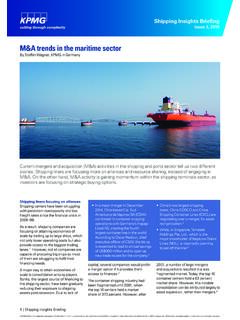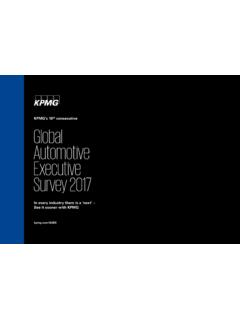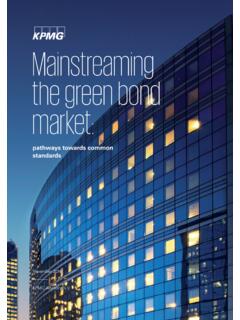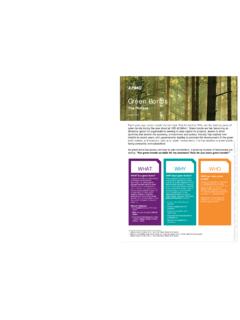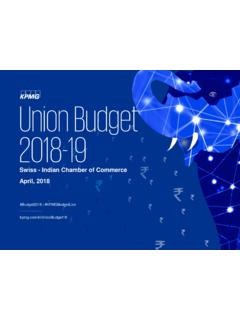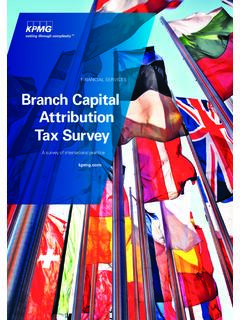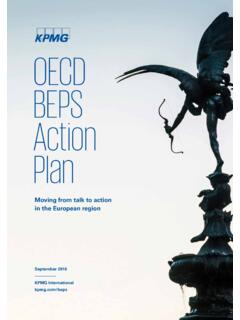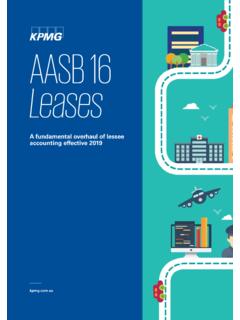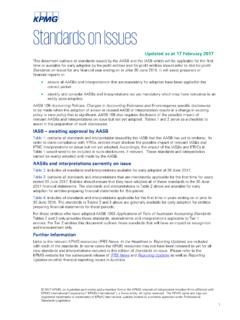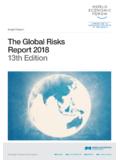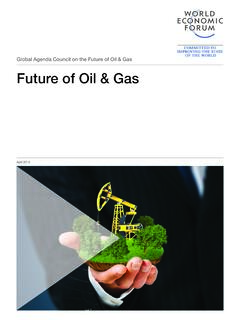Transcription of KPMG Transport Tracker - US
1 kpmg Transport TrackerFebruary / March global Transport Market trends and views 2016 kpmg International Cooperative ( kpmg International ). kpmg International provides no client services and is a Swiss entity with which the independent member firms of the kpmg network are TrackerTable of Contents2 PageMARKET FUNDAMENTALS 4 SHIPPING AND SEA FREIGHT 6 AVIATION 10 EXPRESS LOGISTICS 16M&A AND STARTUPS20 CASE STUDIES24 2016 kpmg International Cooperative ( kpmg International ). kpmg International provides no client services and is a Swiss entity with which the independent member firms of the kpmg network are Tracker3We are delighted to presentthe sixth edition of the KPMGT ransport Tracker , our regularpublication looking at the latestmarket indicators and trends inthe global Transport fundamentalsAviationShippingandseafreigh tCase studiesExpress logisticsM&A and startups 2016 kpmg International Cooperative ( kpmg International ).
2 kpmg International provides no client services and is a Swiss entity with which the independent member firms of the kpmg network are TrackerMarket fundamentalsLong term downside pressures weigh on lackluster economy2015 was far from a strong year on the demand side for most Transport and logistics companies. World trade growth averaged barely 3 percent year-on-year in 2015 ( percent until November 2016) according to CPB statistics and the OECD notes that there had been just five years in the past 50 in which global trade had grown by 2 percent or less (a). The Purchasing Manager Indices (PMI) in the major economies further support this negative view, as both the Chinese and the US PMI ended the year below the 50 percent growth mark, while the global PMI only just reached expansionary figures.
3 The IMF is now projecting global output growth at percent in 2016 and percent in 2017, both of which are slightly lower than forecasts issued in October 2015. On the bright side, European growth is expected to be percent in 2016, an upwards revision of percentage points. Emerging markets growth is expected to increase from 4 percent in 2015 the lowest rate since the financial crisis to and percent in 2016 and 2017, downside pressures such as a slowdown in emerging market economies, China s shift from an export-driven to a consumption-led economy and a geopolitical crisis, were the main reasons for the sluggish growth, the new consensus can also be explained as a plateau effect of globalization: Where trade growth has traditionally outpaced GDP rates by a factor of 2 3, the ratio has now converged to and is expected to remain stagnant in coming years.
4 It now seems that globalization has reached a stage in which supply chains can hardly fragmentise any further as the advantages of offshore production and the subsequent shipping of products to consumers, become smaller amid rising salary and transportation costs. The refugee crisis in Europe poses another downside risk to both Transport companies and global trade in case border checks are re-applied which will result in significantly higher transportation costs and delays in supply chains. The Dutch Transport sector alone is estimated to lose around 600mn a year from the reinstatement of border controls (b). Losses of the British freight industry due to delays in Calais this summer were estimated to be 750,000 ( ) per day according to the Freight Transport Association (FTA) (c). An effect of weak demand and increasing overcapacities was that in 2015, oil and fuel prices ended 40 50 percent below the prior year, trading at levels last seen in 2004.
5 Overcapacities have raised questions on storage capacities and whether the inventory build in 2016 might run into its operational limits. This has led the first traders into chartering oil tankers to use as floating tanks, amid a squeeze on space for growing oil supplies. Soci t G n rale has calculated that Brent will have to fall to US$35 a barrel in order to make floating storage profitable for the strong decline of fuel and oil prices, which has had a largely positive contribution to the earnings of Transport companies, the share prices of Transport companies reflect the rather negative demand sentiment. Amongst the different Transport modes and business models, only airlines (where passenger demand has been less dependent on the overall economy) and Transport infrastructure operators (which are less effected by overcapacities) managed to end the year on a high note.
6 Shipping companies were the worst performers within the sector, as they faced their eighth consecutive year of PRICES(end of December 2015 YOY): Transport and Logistics overall-10%Transportinfrastructure 3%Airlines 4%Road and Rail-14%Shipping -19%(a) (b) (c) Note: 2016 kpmg International Cooperative ( kpmg International ). kpmg International provides no client services and is a Swiss entity with which the independent member firms of the kpmg network are TrackerGlobal Purchasing Manager Indices (PMI)48505254 Jan-15 Feb-15 Mar-15 Apr-15 May-15 Jun-15 Jul-15 Aug-15 Sep-15 Oct-15 Nov-15 Dec-15 global PMIUS PMIE urozone PMIC hina PMINote: Values above 50 indicate growthSource: Institute for Supply Management (ISM), Markit, JP Morgan, ChinaFederation of Logistics & Purchasing5 World trade and industrial production indexSource: CPB Netherlands Bureau for Economic Policy AnalysisFuel and oil pricesSource:Bloomberg, ICE (Intercontinental Exchange)Share prices of Transport subsectorsSource.
7 Bloomberg, kpmg Research405060708090100110120130140 Jan-15 Feb-15 Mar-15 Apr-15 May-15 Jun-15 Jul-15 Aug-15 Sep-15 Oct-15 Nov-15 Dec-15 Jan 15 = 100 Bloomberg 380 Centistoke Bunker Fuel PriceBloomberg Jet Fuel FOB ARA Spot BargesBrent Crued Oil (ICE)0%1%2%3%4%5%6%Dec-14 Jan-15 Feb-15 Mar-15 Apr-15 May-15 Jun-15 Jul-15 Aug-15 Sep-15 Oct-15 Nov-15 YoYWorld tradeIndustrial Production80859095100105110115120 Jan-15 Feb-15 Mar-15 Apr-15 May-15 Jun-15 Jul-15 Aug-15 Sep-15 Oct-15 Nov-15 Dec-15 Jan 15 = 100 Bloomberg World Transportation IndexBloomberg World Airlines IndexBloomberg Shipping IndexMSCI World Transportation Infrastructure IndexMSCI World Road & RailMarket fundamentalsAviationShippingandseafreigh tCase studiesExpress logisticsM&A and startups 2016 kpmg International Cooperative ( kpmg International ).
8 kpmg International provides no client services and is a Swiss entity with which the independent member firms of the kpmg network are TrackerShipping and sea freightNo land in sight 2015 was yet another year lost for the shipping industry which was facing its eighth consecutive year of crisis. World trade grew in a range of 2-3 percent in 2015 which fell short of expectations and far off from historical standards. The Container Throughput Index even signals a declining volume trend towards the end of the year and BIMCO estimates that container volumes on the Far East to Europe trade lane contracted by 4 percent in 2015. The sluggish demand once again stood in contrast to the expansionary tonnage supply as the total world fleet capacity grew by percent according to Clarkson. The total containership fleet grew by 8 percent in 2015 which added to the persisting overcapacities in the market.
9 Subsequently, container freight rates declined by 30 40 percent even as scrapping of capacities continued. In contrast, container charter rates did increase in the first half of 2015 but could not keep the gains as they ended up -10 percent below the prior year by the end of 2015. The containership orderbook at the end of 2015 stands at 18 percent of existing capacity which is a rather moderate increase of ordering activities as compared to the beginning of the year. Total net fleet capacity is expected to grow by only percent in 2016, the lowest ever recorded growth of the global containership fleet according to Alphaliner. Still, this will likely be enough to once again outpace demand growth in 2016. According to the International Monetary Fund (IMF), the volume of global trade, which is key to the demand for container shipping services, will increase by percent in 2016 (2015: + percent).
10 IHS global Insight is forecasting that the global container shipping volume will increase by percent in 2016 (2015: + percent).The situation is even worse for dry bulk shipping companies as the Baltic Dry Index fell to new historic lows in 2015 (a). By the end of 2015, the index had lost around one third of its value from the beginning of the year. This came on the back of a 3 percent increase of total fleet capacity while dry bulk demand slightly declined in 2015. The tanker segment was the main positive exception within the shipping industry in 2015 according to Clarkson numbers. Demand increased by about 5 percent while fleet supply grew by only 3 percent which drove up freight rates and average earnings of tanker operators. As a consequence of the persisting depressed market situation, we saw a number of larger mergers and restructuring efforts of shipping companies across the globe a trend which we expect to continue over the course of 2016 as a sustained recovery is nowhere in sight.
